Home Improvement

Composting is a cost-effective way of turning kitchen scraps and yard waste into nutrient-rich fertilizer. Os Tartarouchos/Getty Images
According to EPA, Americans generate around 292 million tons (265.3 million metric tons) of municipal solid waste annually. Out of this, 52% goes to municipal landfills, while the rest is either recovered through recycling or composting.
Composting is a natural process that involves breaking down organic matter such as food scraps, yard clippings, pine straw, leaves, and coffee grounds into valuable fertilizer using microorganisms and oxygen. Although it may not be cheap, composting at home yields a nutrient-rich finished product that can be used as a natural fertilizer for gardening.
The Science of Composting
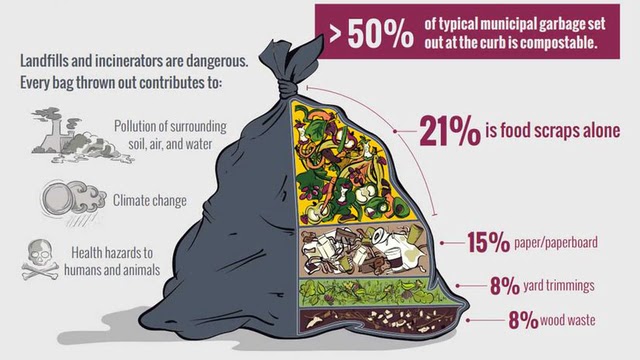
Composting is an eco-friendly way of diverting tons of waste from landfills. EPA
Composting creates the perfect environment for natural decay and rotting processes. It requires organic waste such as woody materials, newspaper, kitchen waste, grass, leaves, and coffee grounds, water, and oxygen.
Microorganisms consume the organic waste and break it down into its simplest forms. This process produces a humus rich in fiber and carbon, and inorganic nutrients such as potassium, phosphorus, and nitrogen. The microorganisms break down the material through aerobic respiration, which requires oxygen. By turning the compost, you introduce air, which provides the required oxygen.
The microorganisms also require water to survive and multiply. During the respiration process, they produce heat and carbon dioxide. The temperature within a compost pile can reach up to 100 to 150 degrees Fahrenheit (38 to 66 degrees Celsius). If you manage your compost pile by turning and watering it regularly, it will decompose into finished compost within a few weeks.
For efficient decomposition, the conditions have to be balanced. You need to ensure that your compost pile gets adequate air, water, a proper mix of carbon to nitrogen (about 30:1), and small pieces of waste that break down faster.
Benefits of Composting
The primary goal of composting is to reduce the amount of solid waste you generate and keep it out of municipal landfills, which could save you tax money. Finished compost is also environmentally friendly and can be used as a natural fertilizer.
Bacteria and fungi break down the organic matter in the compost. Protozoa, nematodes, and mites feed on the bacteria and fungi. Predatory nematodes, predatory mites, and other invertebrates feed on the protozoa, mites, and nematodes. All of these organisms work together to increase the efficiency of the entire composting process by balancing the population of organisms within the compost.
Creating Compost
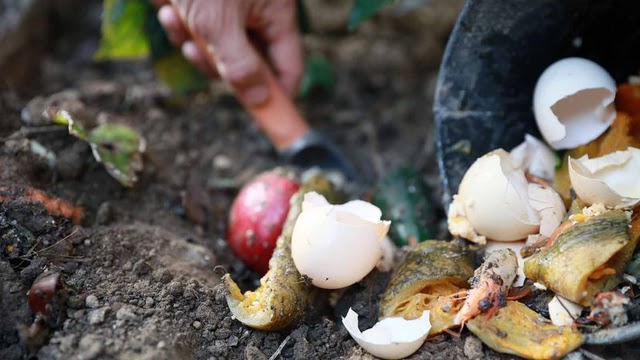
To start creating compost, the first step is to select a location and add the required ingredients. Yifei Fang/Getty Images
The process of creating compost is fairly straightforward:
- Select a location for the compost pile.
- Choose a structure for the compost pile.
- Add the ingredients to the compost pile.
- Maintain and nourish the compost pile.
- Collect the finished compost for use.
Select a Location
The placement of the compost pile is a crucial factor to consider. The pile should be situated far enough from your home to avoid any inconvenience, but close enough to attend to it. However, it should not be too close to your property’s boundaries to prevent complaints from neighbors. Your local housing ordinances or homeowner association rules may specify where the compost pile can be placed. Other factors to consider include:
- Downwind from your house: Even a well-maintained compost pile may produce unpleasant odors at times. While wind provides air, too much wind can cause the material to dry out and scatter.
- Sunlight: Sunlight can help to warm the compost pile during winter, but excessive sunlight can dry it out. If the pile is located near a large deciduous tree, it will provide cool shade in the summer and sunlight in the winter.
- Drainage: Good drainage is essential to prevent excess water from accumulating around the pile.
- Surface: Bare earth is preferable to concrete. Ensure that you have a sufficient working area around the pile (6 to 8 feet or about 2 meters).
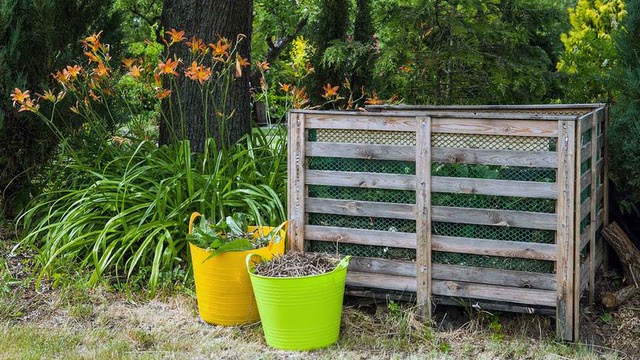
Compost bins are available in various shapes and sizes. You can construct one yourself or buy one at a home improvement store.
JurateBuiviene/Shutterstock
Select a Structure
Compost structures can be as basic as a heap where you pile all the ingredients and let nature take its course; this is passive composting. Passive composting is slower and less efficient than active composting, in which you manage the compost process daily.
You can also construct more complex compost bins using chicken wire, wood, or concrete blocks. They can be simple, one-compartment structures where you add new materials to the top, turn the compost frequently, and collect the finished compost from the bottom.
Multi-compartment (three-bin) structures allow you to add new material to one bin, transfer partially completed compost to the middle bin, and move finished compost to the final bin. The top of the bin should be covered to limit excess rainwater and reduce wind scattering.
However, you don’t have to build it yourself. There are various compost bins available for purchase, including tumblers that allow you to turn the compost with a handle. There are also stacked bins for composting with the aid of worms. Additionally, check with your city or garbage collection company. They may offer low-cost or even free composting bins.
The decision entirely depends on the effort and expense you are willing to put into the project, as well as the amount of compost you need. Also, local regulations may determine the type of bin you can use.
The following materials can be composted easily:
Kitchen Scraps
Most of the things you chop on your cutting board can be added to your compost bin. These items make up the “green layer” that is essential for the decomposition process as they provide the necessary carbon for microorganisms to break down.
- fruit and vegetable scraps: peels, skins, seeds, and leaves
- eggshells
- coffee grounds (including paper filters)
- shredded corncobs: these break down more quickly
- nut shells
- tea bags
- used paper napkins
Yard Debris
Whenever you are doing yard work, collect the debris in a bucket and add it to your compost bin. This creates the “brown layer,” which provides the nitrogen necessary for the composting process.
Be cautious of weeds, as they are hard to break down in home compost bins. Weedy compost can introduce weeds to your garden. It’s best to avoid composting them.
- grass clippings: too much grass can add excess nitrogen to your compost pile and make it smell bad. Consider using a mulching lawn mower instead.
- leaves
- pine needles
- woody materials (branches, twigs)
- straw or hay
- sawdust
- fireplace ash
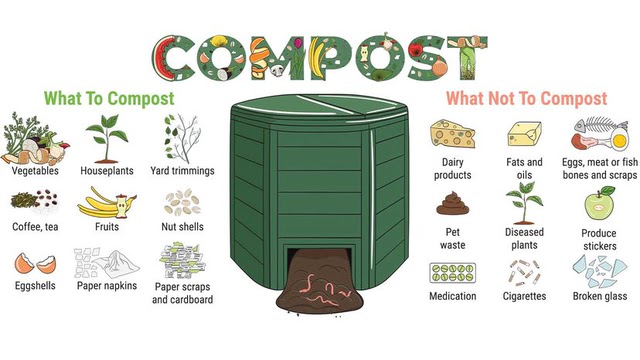
Determining what to compost and what not to compost is relatively simple.
m.malinika/Shutterstock
The following materials SHOULD NOT BE COMPOSTED:
- Human or pet waste, or cat litter: They carry diseases and parasites, as well as cause an unpleasant odor.
- Diseased garden plants: They can infect the compost pile and influence the finished product.
- Invasive weeds: Spores and seeds of invasive weeds (buttercups, morning glory, quack grass) can survive the decomposition process and spread to your desired plants when you use the finished compost.
- Charcoal ash: It is toxic to the soil microorganisms.
- Pesticide-treated plant material: These are harmful to microorganisms, and pesticides may survive into the finished compost.
You may be wondering about composting meat, since eggs can be composted. Meat and bones take a long time to break down in home compost bins because they typically don’t get hot enough. This results in an unpleasant odor and can attract unwanted critters. However, large-scale municipal composters can handle meat and bones, so those materials can usually be composted at the curb.
Maintaining Your Compost

Your finished compost should be warm and rich, with a dark brown or black color. Christopher Hopefitch/Getty Images
It’s best to layer carbon-rich and nitrogen-rich materials in alternating layers, starting with a “green” layer followed by a “brown” layer. Add fresh soil and composting materials to the top, and water the compost bin regularly to maintain moisture. Turn the compost every few days to ensure the proper supply of oxygen. You can use a pitchfork or shovel to turn the pile or crank a handle on your tumbler to mix it up.
Vermicomposting
Vermicomposting, or composting with worms, speeds up the process of making compost. While any compost pile will attract local worms, vermicomposting involves intentionally adding worms to the pile. Composting worms can be purchased or earthworms can be used to seed the compost pile.
As new layers are added and the compost is turned, partially decomposed layers mix with intact trash. The smaller particles of the partially and nearly finished compost settle to the bottom of the pile, and the finished compost is collected from the bottom of the bin. Most bins come equipped with a hatch for easy removal of the compost. In three-bin systems, intact trash is added to the first bin, and partially and finished compost is transferred to the second and third bins.
Collecting Finished Compost
The finished compost can be collected from the bottom of the bin in a single bin system or from the third bin in a three-bin system. There is no exact definition of when compost is done. Essentially, if it looks done, it’s done.
Here are some indications that the compost pile is working well:
- Size: The volume should be reduced by 50 to 75 percent, and gas bubbles may be visible in the pile as carbon dioxide is released during the microorganisms’ work.
- Color: The compost should be dark brown or black.
- Texture: It should be smooth and crumbly.
- Smell: It should have a sweet, earthy smell, like peat moss, and not a bad odor.
- Temperature: The compost should be warm, and steam may be visible on a cool morning as the microorganisms work.
Once the compost is finished, it can be used to:
- Improve soil structure in gardens or yards
- Increase soil microbe activity
- Enhance soil nutrients
- Improve soil chemistry, particularly pH balance
- Insulate soil temperature changes around trees and plants
- Improve insect and disease resistance in garden plants and trees
Most home composters use their finished compost around their own property for their gardens or trees. Some even sell it to local nurseries or other family gardeners.
Composting in the 21st Century
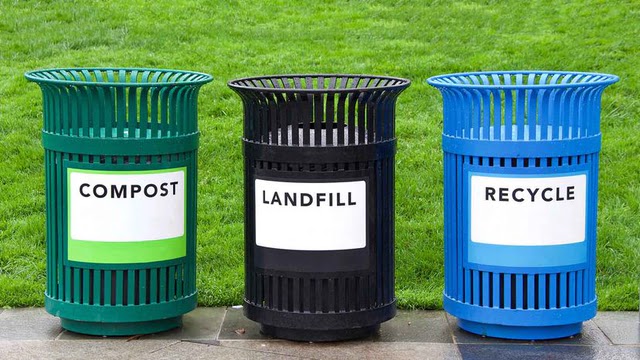
Composting has come a long way in recent years, and now nearly everyone can compost regardless of where they live or what they grow. Suburban flowerbeds, rooftop herb gardens, and country vegetable gardens can all benefit from compost made at home. Additionally, composting keeps a significant amount of waste out of landfills. Many major U.S. cities even offer curbside composting as part of their municipal trash service, with separate compost cans alongside landfill and recycling cans.
When it comes to waste disposal, many cities offer curbside composting programs. San Francisco was the first city to implement such a program, followed by Portland and Seattle, as well as Boulder and Denver in Colorado. In these cities, residents are provided with a garbage can, recycling bin, and compost bin for food scraps and yard waste. All of this waste is then collected and processed at large composting sites.
Other companies, such as CompostNow, WasteNot Compost, and Compost for Life Miami, specialize in collecting food waste from residential and commercial properties. They also sell the compost they create, offering a mutually beneficial solution.
Some restaurants and food trucks provide compostable or biodegradable takeout containers, but these cannot be broken down in an at-home compost pile. They require industrial composting facilities found in cities like San Francisco and Portland. Even non-greasy pizza boxes can be added to these city compost bins.
Why Should You Compost?
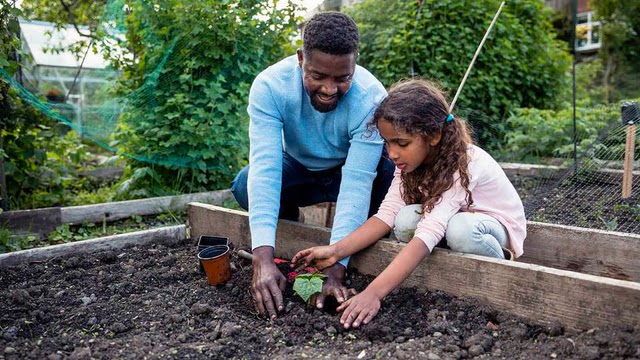
Teaching children about composting is a great way to encourage them to take care of the environment and protect the planet’s future. SolStock/Getty Images
Composting may seem like a lot of effort for little gain, but it is worth it for many reasons. Let’s start with one that is not often discussed: money.
For example, in Portland, Oregon, where citywide composting is available, the green compost bin is collected every week throughout the year, much like the recycling bin. The garbage bin, on the other hand, is only collected every two weeks. Depending on the size of your family, the garbage can will fill up quickly. If all of your waste goes into the garbage, you will need a large bin to hold two weeks’ worth of trash, which can be costly. By shifting most of your waste to the compost and recycling bins, you can save money by choosing a smaller garbage bin.
Even if you do not have access to citywide composting, most areas charge based on the size of your bin. By composting most of your food waste at home, you may be able to downsize your garbage bin and save money.
Furthermore, if you garden, you can save money on fertilizer and store-bought compost for your flowers and vegetables. Even if you are not an avid gardener, you can use your compost to fertilize your lawn or trees for free.
Composting also keeps waste out of landfills, helps plants grow, which, in turn, increases oxygen levels in the atmosphere. Plus, you get the satisfaction of using compost you made yourself with the help of tiny bugs and worms.
Originally Published: Apr 2, 2001
Learn More About Composting
Related Articles
- How Landfills Work
- How Vermicomposting Works
- How Grass Works
- How Organic Food Works
More Great Links
- The Spruce: How to Compost Weeds
- Treehugger: Best Compost Tumblers and Bins
- EPA: Types of Composting and Understanding the Process
FAQ
1. What is composting and how does it work?
Composting is a natural process of decomposing organic materials such as food scraps, yard waste, and leaves into a nutrient-rich soil amendment. It involves providing the right conditions for microorganisms like bacteria, fungi, and insects to break down the organic matter into humus, a dark, crumbly substance that can be used as a fertilizer or soil conditioner. Composting requires four main ingredients: carbon-rich browns (e.g., dry leaves, wood chips), nitrogen-rich greens (e.g., food waste, grass clippings), water, and air. The microbes use the carbon as energy and the nitrogen to build proteins and reproduce, while the water and air help to regulate the temperature and moisture levels of the pile. The end result is a natural, organic, and sustainable way to recycle organic waste and enrich the soil.
2. What are the benefits of composting?
Composting has numerous benefits for both the environment and the garden. Firstly, it reduces the amount of organic waste that ends up in landfills, where it contributes to greenhouse gas emissions and takes up valuable space. Secondly, it helps to conserve water by improving soil structure and reducing erosion. Thirdly, it promotes healthy plant growth by increasing soil fertility, improving nutrient uptake, and suppressing plant diseases and pests. Fourthly, it can save money on fertilizers and soil amendments by providing a free source of organic matter. Finally, composting is a fun and rewarding way to connect with nature, reduce your carbon footprint, and create a more sustainable lifestyle.
3. What materials can be composted?
Many organic materials can be composted, including fruit and vegetable scraps, coffee grounds, tea bags, eggshells, yard waste, grass clippings, leaves, straw, hay, wood chips, sawdust, and shredded paper. However, some materials should not be composted, such as meat, dairy, bones, oils, fats, and pet waste. These materials can attract pests, create odors, and pose health risks. It is important to balance the carbon-to-nitrogen ratio in the compost pile and avoid adding too much of any one material. A good rule of thumb is to aim for a mixture of 2-3 parts brown materials to 1 part green materials, along with some water and air to keep the pile moist and aerated.
4. How long does it take to make compost?
The time it takes to make compost can vary depending on several factors, such as the size of the pile, the ratio of carbon-to-nitrogen, the amount of water and air, and the temperature of the pile. In general, it takes about 6-12 months for compost to be fully mature and ready to use. However, this can be accelerated by turning the pile regularly, adding more greens or browns as needed, and keeping the pile moist and warm. Composting can be done year-round in a backyard compost bin or pile, or indoors using a worm bin or bokashi system.
5. How do I start composting at home?
Starting a compost pile at home is easy and requires only a few basic supplies. First, choose a location for your pile that is convenient, well-drained, and preferably in the shade. Then, gather your composting materials and begin layering them in the pile, starting with a base layer of browns. Add greens and water as needed to keep the pile moist and aerated, and turn the pile regularly to speed up the process. You can also add compost starter or activator to help jumpstart the microbes. Finally, be patient and enjoy the process of watching your organic waste turn into fertile soil!
6. What are some common composting mistakes to avoid?
While composting is a simple and natural process, there are some common mistakes that can slow down or even ruin your compost. These include adding too much of one material, such as too much grass clippings or too many leaves; not enough water or air, which can cause the pile to become too dry or too compact; adding materials that should not be composted, such as meat or dairy products; and neglecting to turn the pile regularly. It is also important to avoid using compost that is not fully mature, as this can damage plants or attract pests. By avoiding these common mistakes and following the basic principles of composting, you can create a healthy and productive compost pile that will benefit your garden and the environment.

Brody is a skilled craftsman and gardening expert. From renovating living spaces to cultivating lush gardens, Brody’s knowledge and passion shine through, inspiring readers to embark on their own home improvement and gardening journeys with confidence.






Leave a Reply